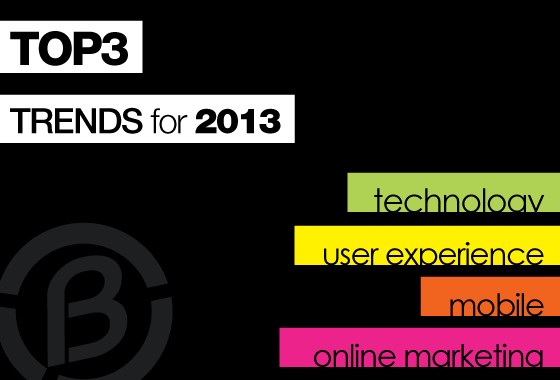
Btrax Design Company > Freshtrax > 2013 Top 3 Tren...
2013 Top 3 Trend Report by Category – Tech / UX / Mobile / Online Marketing
 Looking back on 2012 such things as the rise of smartphones, the large scale release of tablets from multiple manufacturers, the announcement of next gen OS like Windows 8, and the rapid development of online marketing utilizing social media were the main trends. Thinking about all the transformation up to now, 2013 could be a year of even greater change.
Looking back on 2012 such things as the rise of smartphones, the large scale release of tablets from multiple manufacturers, the announcement of next gen OS like Windows 8, and the rapid development of online marketing utilizing social media were the main trends. Thinking about all the transformation up to now, 2013 could be a year of even greater change.
I’ve predicted bold trends for 2013, a year which is sure to be an historic turning point due to the various changes in the environment, in the areas of technology, user experience, mobile devices and online marketing.
Technology:
1. The gap closes between man and digital device
In the last few years the computer has lost its significance, as digital devices have been welcomed into the lives of more and more people. In 2012, Devices such as PCs, smartphones and tablets can be thought to have achieved an appropriate level in terms of the specifications users require. This year signals an end for requirements for these devices to be faster, thinner and lighter, and instead we can expect the release of human centric digital devices that appeal directly to the senses. Rather than simply computing values, the key will be an ease of use so great that you don’t even notice a device’s presence and the completely natural addition of a component of daily life.
Also, further development of devices with AI components such as those exemplified by Nest and Siri, so that as the devices are used they adapt to the users patterns. 2013 may very well mark the birth of the first terminator.
2. Rapid development of automotive technologies
To talk about technology brings up associations with IT tech such as the Internet, PCs and Mobile devices, however, in a car loving country like our’s the evolution of automotive technologies has a huge effect. From features that save lives, like collision safety and accident avoidance, to economically beneficial technologies such as fuel efficiency and maintenance, technology has a lot to offer the automobile. In 2013 attention should be paid to developments in auto technologies.
Google has announced and is currently developing a fully automated car they intend to release in 2017. In the Silicon Valley area, while rare, there are tales of Google car sightings. And actually, there is research indication that one-third of all current car owners have positive feelings about purchasing one. It is obvious then that an era is approaching in which tech giants like Google will be producing automobiles. On the other hand, existing automobile manufacturers such as BMW, GM, Volvo, Volkswagen, Mercedes-Benz and Cadillac are participating in auto-drive races and proceeding with the development of auto-drive technologies.
Perhaps 2013 won’t be the year for that, but the convergence of automobiles and technology can be expected. Even now, cars have automatic collision avoidance and automated parking systems, and the automotive industry has partnered with the net to further the introduction of the most recent technologies as cars are practically turned into smartphones. For example, all dashboard measurements being displayed by tablets, and letting you know the status of all parts such as the engine, tires and battery. Through devices constantly connected to the internet, let alone GPS navigation, you will be able to use services such as Facebook and Yelp to locate stores and friends nearby. Furthermore, using the net, cars will be able to perform software updates to newer and newer versions. Cars will shift from lumps of iron to lumps of technology and transform into something like a giant smartphone.
Just as google above, companies developing Electric Vehicles in the Silicon Valley, like Tesla, will mark a big shift in the automobile market share and we can expect 2013 will be a huge turning point in the automobile industry.
3. An increase in the importance of hardware for innovation
The area I’m paying the most attention to in 2013 is hardware. That isn’t to say the evolution of existing hardware, but the hope for innovation through the emergence of new hardware technologies. There are two big reasons for this.The first is that I have a sense we’ve done all we can as far as on screen expression and experiences for software and the internet and it is difficult to think of any large innovation beyond this. The second is the health of the environment surrounding hardware.
The situation until now has been the development of hardware on a huge scale mainly by companies of a comparatively large size represented by Apple. However, it is becoming increasingly possible for relatively small companies to develop hardware products because of the packaged nature of parts and the simplification of the production process. I also think it will become possible for small scale/capital organizations to begin casually producing hardware products.
Until last year, many Silicon Valley investors were looking for the next Google or Facebook. However, after looking around it became clear that it would be impossible to offer a completely new product using only the screens of PCs and mobile devices, and that without the help of hardware future product developments wouldn’t come to fruition. The investor’s eyes were caught by startups such as Square and Lytro who brought together the net and new hardware.
In 2012, the San Francisco’s startup community saw a steady increase in hardware development teams, and Startup Weekend Bay Area had its first event called “make” dedicated to hardware development. This event was held at TechShop’s Coworking facility. The facility can be used by members paying on a monthly basis. The proliferation of this type of facility is representative of the health of hardware development environments.
The 3D printer installed in this TechShop would have gone for more than 30,000 dollars but now it is possible to get one for a tenth of that. Currently, production of hardware in small lots has become possible and is undergoing a rapid reduction in price. Furthermore,by using services like Shapeways, Ponoko, Sculpteo, i.materialise you can order production of your hardware designs and even get it marketed. Just as servers and service development moved to the cloud, hardware production too will most likely move to the cloud in the same fashion. Also, because of this evolution of the technology and industry surrounding hardware, it will become easy for even inexperienced designers to create hardware products by copy and pasting from existing blueprints. In 2013 smaller startups and individuals will be producing hardware and perhaps even in the near future it will be possible for individual users to customize their designs and specifications.
User Experience (UX):
1. From Specs and Design to UX:
Carrying over from 2013, this year will probably see a further increase in the importance of user experience. Creation of a total experience for products and services will be the most important factor, as it is difficult to inspire people by beauty and simple value calculations. In other words, it wouldn’t be hyperbolic to say that in an age when we have a lot of similar products, rather than “what is it” or “what can I see,” “what kind of experience can I have” becomes the important factor, and it will become possible to begin evaluating products on user experience alone.
To sum it up, this user experience will become a big factor in an industry which undervalues its relationship to technology, and will become a big key to success in each process, such as product planning, production, operations, and promotion. There is even such a thing as a Chief Experience Officer (CXO) at the McCann-Erickson company.
2013 will be a year that sees the success of simple, easy, natural and comfortable user experiences from products, services, stores and planning.
2. The concept of an “interface” will disappear:
The User Interface (UI) is something that is often brought up in relation to the User Experience (UX). PC and Smartphone screens, automobile dashboards, TV remotes etc.. all those points of contact between a device and its user will evolve rapidly in 2013 with the end result being that the people will cease to sense their existence. While of course not actually ceasing to exist, they will exist in such a way that the user doesn’t even notice them. As I posted before, the best interfaces don’t allow themselves to be noticed by the user.
Due to the evolution of existing technologies, the many locations in which humans interact on a daily basis have become interfaces, and a very natural interaction is occurring in these places in user’s daily lives. And what has up until now been input via keyboard, mouse and touch-screen will become a smoother and more direct interaction.
In 2013 existing interfaces will be rewritten to allow 6th sense like experiences via “unseen” interfaces. Using a variety of sensors to receive information in the form of sound, voice, touch, gestures, place, heat, eye movement and smells, devices ill be able to prepare the best output for a given user without the user even notching. This is the beginning of a new era.
3. From a part of life to a part of the body
As time moves on computers are becoming harder and harder to notice with the naked eye. Movement toward the cloud is increasing, and finding its way into daily life. Technology is working behind the scenes to offer useful features. The next evolution of this natural user experience is its incorporation into the human body By incorporating this technology into the body the ultimate user experience will be realized.
Wearable computers have already become a hot topic, with Google offering its face recognition technology “goggles” and biosensor based security systems, development of devices with the ability to provide perfect experiences based on individual users will progress. Digital devices are sure to become a part of the human body in 2013. Although the merger of human and machine sounds like something out of a science fiction horror movie, 2013 may very well be the year such a synthesis occurs.
Mobile:
1. iOS vs Android: Both are winners
For a long time, the battle between the iOS represented by the iPhone and iPad and the Android platform offered by google has been a subject of discussion. Every year, their respective market shares are announced and the market responds accordingly. However, if one takes a moment to think about this calmly, both company will probably do very well in 2013. 85% of smartphone users worldwide use either one or the other of these two devices. Additionally, recently the number of users using both devices has increased, and this will most likely continue along withe the proliferation of smartphones and tablets. Because of that users of both iOS and Android will most likely increase. They are both winners.
At this point concerns shift to mobile devices on the Windows 8 platform. While quite a subsequent development, when one thinks of the unity with PC devices, the possibility that 2013 will be a rewind is not small. On the other hand, the perception that RIM’s Blackberry has seen its last days is quite strong.
2. Mobile Commerce will begin to spread
In the ecommerce industry sales from mobile platforms are not huge. However, 2013 will probably be the year that people begin to focus on mobile commerce. The reasons for this are that, in addition to those that use both PCs and movie devices, users who use only mobile devices and those that use them as their main device will increase, and the average age of those users will also increase. Most ecommerce sites use credit card payments as their preferred method, and the sales estimates for users under 18 has been extremely low. However, most teenagers spend longer amounts of time on mobile devices and it is to be expected that they would use these devices for online shopping. Just as there were those consumers several years ago that didn’t have credit cards, we can expect that cases in which people order things from their mobile devices will increase. In sync with this trend, popular online stores such as Fab, eBay, Etsy and Amazon are planning the development of their mobile sites and applications.
3. The decline of AR and Virtual Screen services
For several years now people have been watching services utilizing the full featured smart devices to deliver “virtual screens” or artificial realities. However, in relation to the largesse of the concept and impact of these services, many say that they are unpopular and unprofitable. In actual fact, there are few people using practical, game or advertising applications that use AR, and there are several cases of these not succeeding as businesses. Further, the flames have cooled since the inception of social TV startups such as Zeebox, GetGlue, Miso, IntoNow which use virtual screens.
Its safe to say that hits in the mobile industry in 2013 will be highly practical and gimmicky services that place impact over practicality will cease to garner appreciation.
Online Marketing:
1. The preeminence of visual elements.
The main trend in 2012 online user activity was picture sharing. In addition to the popularization of Instagram and Pinterest, over half of social media users are sharing photos on a regular basis. Before, there were few cases in which users would share photos across sites, but just as in instagram and interest this is rapidly increasing.
However, blogs are only the beginning of the increase in written content, and we are rapidly approaching a situation of overflow of the users reading capacity.
Because of this, many American companies are reevaluating the importance of visual elements to online marketing. In marketing it is becoming more important to “show” users rather than simply “tell” them and the number of companies using interest as a marketing pillar has increased. A trend for 2013 will be a shift from display ads to softer approaches like infographics to boost name recognition, traffic boosting, picture sharing among users and the popularity of a visual communication that goes beyond language to appeal to a broad base of cultures and nationalities. A big opportunity for creatives.
2. An increase in the accuracy of effectiveness measurements
The measurement of the effectiveness of campaigns in online marketing has a very important role. Through a detailed understanding of the type of results achieved by various strategies one can get closer to the desired result. An marked increase in the ability to measure this effectiveness will occur in 2013. Specifically, the realtime analytics and analytics of social media. The need to wait hours or days before seeing the result of a campaign strategy will disappear. There will be a marked increase in the number of specific tools to measure real time communication platforms like Twitter and instantly gauging user response will become possible. Further, we will most likely see the ability to obtain real specific conversion data in relation to specific strategy outcomes in the field of social media which has up until now been at best, unreliable.
3. The keyword is SoLoMoCo
The development of corporate marketing and branding will become user based going forward. It will become important to target communities in even more specific ways. A new buzzword amongst American marketers is SoLoMoCo, or Social, Local, Mobile, Community and this demonstrates the importance of these to online marketing.
- Social – User based social media campaigns
- Local – Campaigns and Branding that match their environments
- Mobile – Mobile devices as a main target
- Community – Community based marketing of products and services
From here on, consumer focused promotions of products and services will be the norm, and advertising and marketing campaigns will become the stage hands that support them.
What kind of year do you think 2013 will turn out to be?
Author: Brandon K. Hill / CEO, btrax, Inc.







